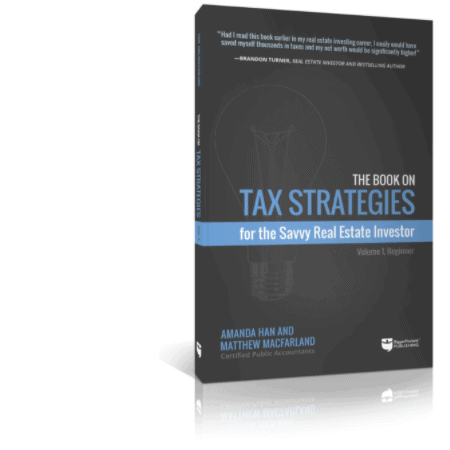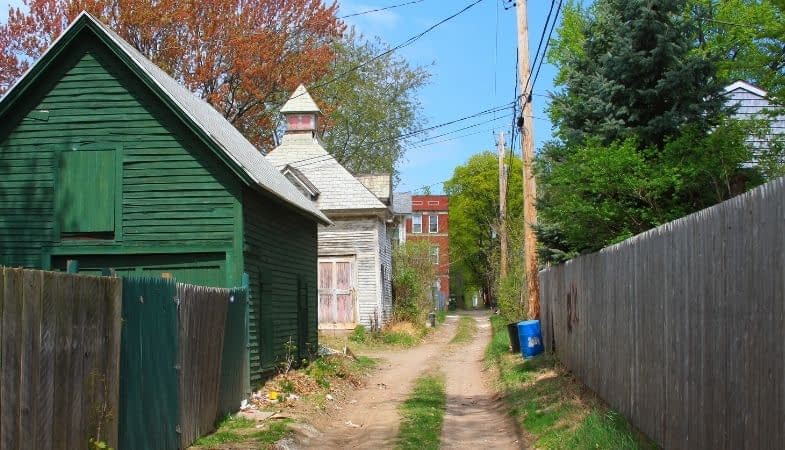Ashley:
This is Real Estate Rookie episode 165.
James:
I always tell people there’s two ways you can learn construction. You’re either going to lose a lot of money and you’re going to buy that thing and you’ll figure it out the hard way. Or you can take baby steps and start interviewing people, talking to people, but also go out and start shadowing with investment companies.
Ashley:
My name is Ashley Care, and I’m here with my co-host, Tony Robinson.
Tony:
And welcome to the Real Estate Rookie Podcast, which is in my opinion, the best podcast on the planet for new real estate investors, because every week, twice a week, we give you the stories, the inspiration and motivation to kickstart your real estate investing career. And if you’re already investing, hopefully we’re giving you the motivation to keep going and build an even bigger, better real estate business for yourself. So what’s going on today Ashley?
Ashley:
Not much. We just got a ton of snow in Buffalo. It was a holiday yesterday, so if it wasn’t a holiday, all the kids probably would’ve had a snow, but all my friends and their kids went out skiing and snowboarding in the fresh powder and I just sat at home and powdered because of my bump knee. So I do, I am having surgery February 10th. So I think this episode will have already aired by then or won’t air or the surgery would’ve already happened by the time in this airs. So I’ll probably hopefully be in rehab and recovering and have a complete ACL and MCL again.
Tony:
There you go. Back to old Ashley. So just no more snowboarding for Ashley, right?. You can just at walk from the side.
Ashley:
AT least not for the next six months, but next season, oh yeah, I’ll be back up there.
Tony:
You’ll be back out there. Okay. Are there like training wheels for boards. Like how can we get you like on a… or we’ll just keep you on like the bunny slopes next season?
Ashley:
No, actually Tony, I’ve been snowboarding since I was like 10 or 12. I’ve snowboarded it for a very long time. I just thought that I was-
Tony:
You were feeling a little gray that day.
Ashley:
It was like my first time on a super big hill and I went way too fast. It was definitely user error. Like me just thinking that I was… my body was still 17.
Tony:
Yeah, you got humbled is what it was.
Ashley:
Yeah. So and then I went into a woods trail and I hit some roots and they just flung me and ping pong me off trees, but…
Tony:
Well, hopefully this is the last time. I don’t have any torn MCLs or ACLs, my life isn’t as exciting, but…
Ashley:
Yeah, you’re actually getting a better shape.
Tony:
I’m trying to.
Ashley:
You have your fitness competition-
Tony:
Yeah. The fitness competition is coming up.
Ashley:
… you haven’t talked about that in a while.
Tony:
Yeah, it’s actually a little less than 10 weeks away. So it’s nine weeks and like five days away. I’m honestly really excited mostly because I’m kind of over the diet and waking up at the crack of dawn to do cardio and just eating every three hours. Like it’s starting to weigh on me. So I’m praying for the end competition, but it’s always fun. It’s always a good challenge. So I’m looking forward to it.
Ashley:
Yeah. When I went to Tennessee to visit Tony and record a podcast live there, he had all his meals that he had brought with him from California. And it’s like, I don’t know, 11:00 at night, everybody’s having a drink playing pool and there he is sitting at the kitchen table eating one of his meal.
Tony:
Eating some ground Turkey meatballs. Good times. Good times. Well, we got a crazy good episode today. And for the rookies that are listening, this might be my most favorite episode that we’ve done so far are only because our guest goes so deep into flipping and specifically on like how to estimate your rehab costs and there’s so many pieces. But today we have James Dainard on the podcast. So Ashley, you know James pretty well, just give like a really quick why we brought him on for this episode.
Ashley:
Yeah. So James Dainard and I probably met like a year and a half ago. He’s an investor out of Seattle, Washington. And every time I am with him, I’m mentally taking notes or I’m physically taking notes and scribbling down as much information as I can about what he is saying. So I finally found a way to get him onto the Rookie Podcast because he is not a rookie, but Tony and I have decided that we want to kind of incorporate and add into our series, having some experienced investors on where they just go down into a niche.
So today’s niche is going to be construction cost and doing a rehab. So this could be, if you’re doing a flip, this could be, if you’re doing a BRRRR for rental property, we are going to break down exactly how James process works and what his system is for getting a property, estimating the budget, getting contractors, how to find contractors, putting together the contract, putting together the scope of the work. So a ton of great information. And we actually had to, I get into two episodes. So on Saturday, instead of our usual Rookie reply with questions, it will be a part two series with James Dainard. So let’s get to it and let’s bring James onto the show.
Tony:
James, welcome to the Real Estate Rookie Podcast, where they’re super excited to have you on. I’ve heard so many amazing things out you from Ashley. So I’m glad to have you here, glad to share your story with our audience, well, welcome board, man.
James:
Yeah. Thanks for having me on. I’m excited to be here. I had many late night conversations with Ashley, so now we got to do a formal interview.
Ashley:
It’s only taken two years of knowing me to finally get on the podcast.
James:
I know, I’m starting to feel a little rejected at this point.
Tony:
Yeah. So James, for those who or for those that don’t know you, if they want your full backstory and all kind of how you got started in real estate, if they go back to the Real Estate Podcast, episode 338, you were interviewed there, you gave your whole backstory, but if you can just give us like a 30,000 foot view quick snippet of kind of who you are, what you do, what’s your businesses and what you’re going to talk to us about today.
James:
I’m James Dainard, I’m an investor out in the Pacific Northwest. I’ve been an active real estate investor since I was 22 years old, when I was a senior in college. We since kind of starting our company in college, I went from door knocking to buy my first deal. And then since then, we kind of expanded out and created a multilevel real estate investment company to where we own a brokerage, this source is on and off, market properties, we have a lending arm that finances investors in Washington State with hard money, short term construction financing. And then we are very active investors in general. We’ve been involved about 3,000 homes and 3,000 transactions with investors in the last 15 years. So we’re just an active shop.
We’re known for value add construction. A lot of the deals that we do with our clients and ourselves are heavy value add where we’re buying something that where the numbers may not look good on paper at first, but the right construction plan then allows us to kind of maximize it out. So currently right now, we’re working on about 30 flips ourselves, fix and flip. And then we have about 400 apartment doors under construction. So we do a lot of heavy lifting, a lot of construction plans. And then we like to get our hands dirty. We’re not really carpet and paint guys. We want to see the potential in the structure and kind of rip it apart. So done a lot of constructions, seen a lot of different things, probably crazier things than what people can ever imagine, but we’re just very active investors in the Pacific Northwest.
Ashley:
So I’m actually doing one of those flips with James. I’m doing my first flip and we are actually documenting the whole thing. But I flew out there for my first time to look at the property that were flipping and I got to see James process as to, “Okay, this is how we analyze a property that needs rehab. This is how we build the scope of work.” And I wanted to have him on today to kind of talk about the process of doing a rehab.
So kind of, you get a deal, you get a lead in, what do you do with the property to kind of estimate your rehab is? And then once you get to go look at the property, what are the things you should be taking with you? What should you be looking at? What do you need to know when you’re looking at the property? And then lastly, once you get that property, bringing in contractors, scheduling them, how that all works. And then most importantly, like building your budget, what are the construction costs going to be? So James you want to kind of like kick us off here as to what’s the first step when you get a lead that you want to analyze for a rehab.
James:
Yeah. The first step that we do before we bought any property, and we’re active investors so we buy all sorts of different types of things. Some are even new projects for us where we’re maybe buying something that we’ve never done before, we have to build a new process. But it always comes back to before you buy that first rehab, and I did learn this the hard way, is you want to build your team right, because everybody is out there and is chasing the deal right now. There’s no inventory. It’s hard to get that next goodbye. But you know, I hear it all the time, there’s no deals out there. Well, there is deals as long as you can put the right plan together. And the right plan together, it means that you have the right bench and the right resources to kind of make the margin.
A lot of times when you’re, Pacific Northwest, we have a very expensive market, it’s hard to get a deal. What we say is we have to vent the return. The right plan will create the right profit margin. But that comes down to building your bench. And before you jump into your first rehab, you want to make sure, one thing that we always do, is we have three active general contractors that we’re currently working with. The reason why we always have three is because sometimes they’re busy and their pricing might go up at that specific timeframe, so we always want to get three quotes and we also have two to three subcontractor trades for every line item in the house. So we have two to three plumbers, two to three electricians, two to three framers, two to three roofers and on from there, because as the market gets more expensive, it’s more competitive, the margins also get more compressed.
And so you always want to make sure you have that bench to where you’re not getting stuck with the same guy that’s giving you one price that you have to go to that price commitment. So go out there, build your bench, find your contractors, you want to go out and talk to investors, go to meet up groups and start talking to people and then kind of getting qualified from there. Or start talking to them about pricing and find out if they work with investors and kind of build that bench to where, when you go out to that project, you’re bringing out people that are, A, used to working on your type of business plan and then also that you can make a quick decision because if there is a good deal on the table, you can’t sit around and wait for it. You got to pull the trigger quick. The biggest thing is, go out and find those contractors that work with flippers or BRRRR people or investors. They can’t be the contractors that are working on your mom’s house. That’s a different type of contractor.
And so you want to go find those people and then start kind of getting them in the door. And then also at the same time, before you get going and you buy your next project, you want to make sure that you have an understanding of construction. And if you don’t, you want to take baby steps and start looking for different types of projects are smaller ones. I had to get a crash course on… I mean, I always tell people, there’s two ways you can learn construction. You’re either going to lose a lot of money and you’re going to buy that thing and you’ll figure it out the hard way. Or you can take baby steps and start interviewing people, talking to people, but also go out and start shadowing with investment companies, see how you can be of service to other big investors. And they’re going to teach you the ropes for free because you’re being of service to them.
Tony:
James, so much good information. Like my head’s spinning already and we’re like five minutes into this conversation, but I want to circle back about the team building, but before I do, I just want to highlight one thing that you said, you said you have to invent the return. And I’ve never put that way before, but what are great phrase. People, especially in today’s climate, feel that there are no good deals out there, but to your point, if you can find the property and develop the right business plan around the property, that’s how you find a good deal. I didn’t want that to kind of go over peoples head, but what a cool phrase you said there.
I want to go back to the team building James, because I think for of our listeners, these are first time investors, people who are aspiring to do a deal, but really haven’t done them before. So if I’m that new guy or girl that wants to get started, where am I going to find these contractors? Even for me, I was doing a flip out here in Southern California, I was looking for another contractor and no one wants to share who their contractor is because they want to keep their contractor for themselves. So where am I going? Who can I reach out to? What resources do I have as a new investor to find that contractor and start building that team?
James:
Yeah. And that’s a question we’re all having right now because since the pandemic, there’s been all sorts of things that have happened. Material cost has spiked, there’s labor shortages, and it’s harder and harder to find guys. I mean, even for me who’s been doing this for almost 20 years in the Pacific Northwest, I know a lot of people, it can be tough right now. And so the ways that we have found additional contractors, there’s a couple different things that we’ve been doing. We had to, A, we had to invent the return again. We had to create different are types of ways outside the box to find these resources. Our favorite way right now is to find actual contractors that are used to working on our model. There’s two things we do, we track permits. So I go around and I look on the Pacific Northwest, there in general, you can go through and look at what investment properties were sold, whether it was at a foreclosure auction, it could be a bank on property, it could be a fixer.
And then in the Pacific Northwest and almost every different state, you can actually pull in and reverse engineer and find out if that property address, like I can go on City of Seattle Permit Center, put an address and that’s going to give me every permit that’s been pulled on that project. If it’s a flip project and I know an investor bought it, that means most likely those trades are already going to kind of be in my wheelhouse for what I’m trying to accomplish. They’re used to working for fix and flip people, they’re working for investors in general. And so what it does is it actually gives me a call list as to where I’m not going on the internet and searching out plumbers and looking for 100, I’m now looking at 10 and out of the 10, I kind of shrunk my box into people that have already working for people like me. That’s our favorite way to do it.
In addition to, people talk about driving for dollars for deals, I drive for dollars for contractors. If I have an open day, or if I’m out looking at projects and I see a house that’s being flipped, I stop in, I introduce myself to the contractor, I explain who we are and that we need more kind of work and then we start interviewing them right there. In addition to, I can kind of see those people working on site. If I pull up to a flip house and the site is completely messy and there’s doors falling apart, windows, there’s garbage everywhere, I don’t want to hire that guy anyways. And so it’s actually the best kind of interview process because I got to see them working. And then also kind of see what they’re doing, I can ask them what they’re charging the people on site. And so I can visual kind of look at that.
So A, I track permits, I drive for dollars. And then the best thing too is just working with other investors for new people like in the Pacific Northwest, find the right brokerage and the right team, you know it goes back to building your team, for our investors, we have a resource list for them. So when they buy a property through us, we’re not just your traditional real estate brokerage, we’re here to service the client all the way through, not just find them a deal, we want to make sure that they can execute on the deal. Part of executing is giving them resources. So we are constantly filling up our electricians, plumbers, flooring and all our trades to where we know that we can refer them out to our client and that they can be successful. We don’t want them overspending their budget because we want them to maximize out that deal.
So work with maybe a right brokerage. If you find the right broker, there are brokers that focus on just investors. They typically are going to have referrals for you too. Another good way that I’ve been finding tradesmen too is I actually talk to my suppliers. I recently called my cabinet shop who we refer a lot of people to them, well, probably 100 to 200 jobs a year, and I called them and said, “Hey look, we’re giving you all these cabinet orders, you sell flooring. I’ll tell you what, I will buy all of my flooring and refer all of my flooring to you if you can give me six installers.” Because the flooring company I was working with was starting to get busy, they were starting to get expensive. And so I asked my vendor for help. And then he referred me five good contractor or flooring installers that work for investors.
And so just anytime you’re out talking to anybody, just ask the question, “Hey, who do you know that does this?” If you’re giving someone business, ask them for some favors back. If one of my clients calls me and says, “I’m jammed, I need an electrician for my house.” We’re going to go help them find that because as a broker and being a team member, we want to make sure they can get through that project, so then I can list that project down the road too. So as you’re trying to find contractors, drive for dollars, look for permits, work with the right type of team members, the right broker, the right hard money company. We finance people too in the Pacific Northwest. We also would refer them contractors too if they’re in trouble because it’s in our best interest for them to get that house done, because we lent them the money. So really build that good team and that team can give you tons of different types of resources.
Ashley:
James, once you get these referrals or you get these people, a list of contractors to use or vendors, what’s the next step after that? How are you actually vetting them? Or are you’re just taking someone’s word for it that this contractor will work?
James:
That’s a great question, it’s… because that is tough, right? People will tell you whatever you want to hear. Especially in real estate, you have mortgage guys that will always be able to get your loan done when it might be more complex. You have contractors that, “I can do a great job for an amazing price,” but you don’t know who they are. And depending on your state too, like in Washington State, it is not complex to become a contractor. You fill out a form, you send in a check, you get a bond and you are magically able to rip a house apart, which is kind of crazy because construction is complex in general. But the things that you always want to check before you hire those people, so what I do on every referral or every generalist referred to me is, A, I want to check the source. Who referred them to me? How many projects have they done? Have these people worked for those people before? If it’s just like, “Oh, my buddy told me about this guy,” then it’s not that good of a referral.
And then when I get these people on the phone, the first thing I ask for is what’s their license number. I will not hire unlicensed people. We pull a lot of permits, there’s a lot of liability in not doing so, you can get fined. So we want to make sure that they have a license. The other reason I like to hire and make sure they’re licensed and bonded is because that means they can run a actual professional company. You’re not just hiring some random guy that’s going to tear your house apart that can cause a lot more damage for you down the road. So you want to make sure that they’re licensed, that they’re bonded. I actually check to see how long they’ve been in business too on their license. Like if they just got their contractor license four months ago, I’m going to ask them where they worked prior before that. Like did you work for someone before? Or if they said, “I had a different company,” I want to know what happened to that company. I want to know the name of that company.
I’m going to pull up to see if they had any claims, because you can also check online to see if they have any claims against their bonds. The other thing I want to do is I always make sure I get addresses of three recent jobs they did for investors. Not for a homeowner, they need to be the same… Remodeling for homeowner is different than remodeling for an investor. So you want to make sure that you get the addresses of the projects they worked on. I like to pull up those addresses, see what they sold for. I want to see what the pictures look like. I want to see how long it took for it to sell too. Because if it took 90 days for it to sell in a market that usually takes five, was it a pricing issue or was it a quality issue?
And so those are things that I’m always going to check. And then I always get the name and can refer to. The name of someone that can get me actual references. I want to talk to them on the phone. And this is all a lot of work and it can be quite invasive. A lot of my clients are like, “Well, the contractors get a little annoyed when I ask these questions,” and I’m like, “Well, if they’re getting annoyed by you… these are all valid questions, probably not the right person to be hiring.” And so if someone pushes back on these questions, I instantly cross them off my list because nothing’s worse than hiring the wrong guy. And so those are always my first set of questions. And then I go into my pricing questions from there because I want to make sure, A, that they’re qualified, but then also they can actually do what I need them to do.
Ashley:
James, before we go in to the pricing, why do you prefer contractors that have worked for investors and don’t care if they’ve done work for homeowners? What’s the difference there?
James:
The reason being, like if you’re working for a homeowner, and this is why I would never do a renovation for a homeowner it’s, it is a different business. Construction is not all the same. Commercial construction is not the same as residential construction. Multifamily construction’s a lot different than actually fix and flip construction a lot of times, like how you do it, how you… what kind of materials you’re putting in. Custom and homeowner construction is also completely different, because they’re usually pricing things up higher because to be perfectly honest, investors are a lot of times easier to work with than a homeowner because you’re not building your dream house, you’re building a home that can create revenue and can create a return or maybe it’s a rental property that you’re trying to keep your cost down and you’re trying to make it more bulletproof rather than visually appealing.
A homeowner changes their mind a lot. And so contractors build that into their pricing. They got to have way more conversations with the people, they got to get a lot more feedback, the people will be moving things a lot more. Just like when I’m doing construction on my own personal house, I have a lot more opinion on it than I do a flip a lot of times. And so those guys, they’re used to dealing with that, like a custom build, there’s a lot more expectation, there’s a lot more personal opinion. And so you should charge more for that. It’s no different than if I’m buying a fix and flip property and it has a lot more hair on it, I’m expecting to make more money because it’s more complicated. If you’re a contractor and you’re working for a homeowner, it’s going to be more complicated most times.
The other thing is too, it’s about the subcontractors that they’re actually trying to go find. If it’s a custom home builder, they’re going to usually get their supplies from a very consumer friendly shop where they can send their customer down to a design center. They’re going to work with a designer, they’re going to pick out all their materials and then they’re going to put the plan in play, whereas we don’t do that. We pick the materials first, we pick the budgets and then give it to the contractors, so then we can control the budget. So it’s just a different format and it’s a different end product at the end of the day as well.
Tony:
Yeah. Thanks for clarifying that, James. I think that distinction is really good to know. I just want to go back to the event, the return point you made. Really quickly one more time. I think that I understand at a high level what you mean by that, but I think some of them are listeners might be wondering, what does that look like in real life? So when you find a property, how are you finding that undiscovered potential that maybe other investors are passing out? What is it that you’re looking for? How do you know if it has the opportunity to have that in turn or that return invented? Give us some insights into what that looks like.
James:
That’s a great question. And that always comes down to, are you creating the right plan and are you able to control the costs? Because fix and flip or BRRRR properties, they’re all the same. We’re buying something at a certain price with a certain margin in it. The middle is going to dictate how good of a deal that is. If you buy something at 60 cents on the dollar, like you can buy it for 60 cents, it’s worth a dollar. That sounds like a goodbye, unless you’re are spending 45 cents on your renovation, then you’re over market at that point. And so it comes down to what’s the middle number. And so what we do is we’ll look at it a lot… Every deal I look at, we cut it up three different ways. We’re going to look at it, “Hey, what’s it going to look like as a cosmetic turn?” If we just do carpet, paint and a quick turn, that’s usually going to be a lower profit, lower renovation by a higher cash on cash return on an annual basis.
That’s where most people are going to look, right? Most investors, especially right now, there’s a lot of newer investors in the market, they’re going for the normal plan that everybody’s looking at. You know, I got a four bedroom, two bath house, a comp is a four bedroom, two bath house, I got to replace the cabinets, countertops, windows and then that’s going to get me at this price. Whereas we might go in and say, and they’re going to spend $80,000 to do that, we’ll go in and go, “Well, instead of spending the $80,000, because that’s usually investors’ first question is, “How can I get this renovated for as cheap as possible?” Sometimes renovating it for the cheapest possible thing is not the right plan. Where we’ll go in and say, “Well, instead of having a four bedroom, two bath house, we’re going to rip this all the way down to studs and spend $150,000 on it instead and it’s going to take us three times longer, but we’re going to create $200,000 more in additional value.
And we’re not afraid to go for that higher… we always want to know what highest and best use is for the property. And it doesn’t matter how complex the plan is, as long as the return’s higher at that point. And in Seattle, there’s a lot of really old homes, 1900 and 1920s with old basements, they need a lot of structural work, a lot of reconfiguring. The more reconfiguring you do, the more complex and harder that it is at that point. We’re just not afraid of the hard work. And then part of that is we know the cost that it’s going to take to get it through the hard work. If you don’t know the cost, you can’t estimate it correctly. So if I’m doing a studs down house in Seattle, and I think it’s going to be… I’m saying it’s going to be $200,000, I’m going to break down how I’m going to get there.
If I bring a contractor out and I can’t control that contractor and the construction to keep it at $200,000, I can’t invent the return then at that point if every other contractor’s coming out and saying it’s $250,000. So what we do is we look at the total budget and we don’t just go to the normal route of hiring a general, putting the plan in play. We hire a general, look at where he’s expensive, take those items off, plug in our own guys to take our costs down and that’s how can create that margin at that point. So we’re not creating the margin on the buy, we’re creating it by reducing cost and putting the right plan in play. And that’s why we say, we invent it because it’s really on us moving the pieces around rather than just going A, B, C make your profit at that point.
Ashley:
Can you give us an example of that? Like a project you’ve worked on recently, what were some of the things that you took out that you put your own people on just to save some money?
James:
Yeah, so they’re… I like to call it the bundle method in construction. I like to get a full scope of work for a contractor, and I get all their… and when I get my scope of works, I always make sure that they’re broken down for material costs and install costs. I don’t get lump sums. I want every line item broken down at that point. That’s how I can kind of invent that return, because I can pull out the expensive parts.
Ashley:
And that’s another thing too that you should expect from your contractors. How you said, if they’re like getting annoyed or mad that you’re asking so many questions, they shouldn’t be annoyed or getting mad that you’re asking for this breakdown. Because if they’re actually taking the time to actually put together a valid budget for you or an estimate for you on the cost of this, that shouldn’t be a problem to get that breakdown.
James:
Yeah. And you don’t want to burn out your construction team. I mean, if you’re a difficult client, no one’s going to want to work for you. And so it’s about having really good communication with your construction guys is, if I have a general come out and he bids electrical for… he has his own electrician. That’s his guy or his two guys. He is also dictated on their pricing at the time. We don’t know if his two electricians are really booked out and maybe they’re charging a little bit more because he’s charging their cost plus 10% to 15%. And so I’ll just ask the question, say, “Hey, your electrical is really high, what’s going on?” And he might say, “Well, our guys are busy, costs have gone up.” So what I offer him, so then it still makes it worth his time, because if I have a really good general, that’s going to show up and do his job and has good communication and works with me, I want to keep him on my team and on my bench.
I’ll give him an offer. I’ll say, “Hey look, what I can do is I have three more electricians. Let me price this out.” And if they come in lower than his, he’s at $20,000 and let’s say my guys are bidding at $15,000. And that’s where it goes back to that bench, always have three people on your bench so you can plug this in. So I’ll get three quotes and then I’ll take my lowest quote and say, “Hey, I’m going to use this guy instead, let’s pull this off your scope of work.” If he has to manage them at all, I’ll still pay him his 10% on top of my bid, because he’s still doing the work. So I’m just saying, “Hey look, I’m still paying you, I still want you to do the work, but I just want to plug this guy in because it ends up going back in my pocket.” And typically, people are going to go, “Yeah, that’s a good way,” because you’re still taking care of your general, he’s still going to help run your site and at the same time you can reduce your cost down.
Typically, in the bundle method, I like to have my general do the framing, the plumbing, the electrical, the windows, the gutters, the roofing at that point. But if any of those line items are high, I will pull them off, let the contractor kind of help me put it in play, pay him for it. Or maybe the guy that wants nothing to do with it. A lot of time generals are bidding stuff high because they don’t actually know how to bid it. They’re going to say, “Well, I don’t want to get burned by my electrical quote because there’s so many variables in this house. You got to take down studs, we got to run new 200-amp service, we got to bring the meter in, whatever it could be.” And because they don’t know they’re throwing a real high number at it. Whereas, I like to know my number’s going in and so you’re almost doing them a favor at that point because you’re taking off the unknown and you’re plugging in an actual at that point.
Tony:
So James, you clarified a question that I had earlier, but I just want to make sure that I’m understanding it the right way, because you said up front that you like to use GCs. And you said you have about three general contractors that you rotate through, but you also said you keep two to three subcontractors. So the reason that you also keep the subs on your team is for this like substitution method that you just talked about?
James:
Yes, correct. Yeah. So we can always… So it really makes us and our general as a team. It’s better for them if I’m making money and I can go buy another house and they can keep working. I’m still paying them, but I’m giving them additional resources at that time. It helps them out, it keeps their cost down. And I always want that option because as a house, it’s not different than any business.
If I’m a manufacturer selling this pen, I got to sell this pen, I need to buy these. I sell 10,000 of these a month. I’m always going to have a backup supplier because if I can’t hit my… for some reason, this pen company goes out of business, I need to make sure I can still sell them to my customer or if this pen suppliers telling me that one cent today could be one and a half cent tomorrow, back down to one cent and then that’s messing up my margins, I need to be able to plug in that backup and kind of help keep your margins the same. And it is just, you have to have those people in line because just like anything, if you call that person and they’re busy, it’s going to cost more. And so you have to be able to outlay out.
Ashley:
So now that we know how to find a contractor, how to use a general contractor, how to bundle, use the plug and play. Let’s talk about actually getting together a pricing, a budget sheet before you even go and see the property to help you accurately analyze the deal. So you talked about how you get pricing from contractors before you even hire them. How does that incorporate with your budget sheet?
James:
That’s in a very important question. Because we budget, it’s all based on logic. Budgeting should be treated the same way as the analysis for the sale or the rental, the lease up. If you want to know how much it’s going to lease for you, pull comps. You want to know how much it’s worth, you pull or you pull rental comps. If you want to know how much it’s worth, you pull actual comps. So with contractors, we want to be able to break it down the same way. So what we do, the best thing that we did and this, we started doing this about five years ago, is instead of going lump sum, when we were first brand new investors is it would be like, “Hey, we need a kitchen, we’re going to put $10,000. We need a roof, it’s going to be $10,000. We need to rewire, it’s going to be $12,000.” It was always those lump sums and it was just a rough ballpark.
And that’s not a terrible way of doing it, it will kind of give you like a ballpark. And it also worked a lot better when there was tons of contractors around. That worked well in 2012 to ’15, because there wasn’t as much work for guys. And so they would do more to make that deal work. Now there’s too much work and there’s less guys and so what we want to do is how we break down our budgets so we can do the plug and play is we take all of our line items. If I’m calling an electrician, I write down what scope of work do they typically do. Well, I know they’re going to do a panel. I know that they’re going to knee a meter. I know that they’re going to do a mask. They’re going to possibly fully rewire house. They got to trim the house out and then they need to install fixtures. Those are the core things that I need to know in a house.
And so when I’m talking to an electrician, the first thing I do is I qualify myself and say, “Hey, we’re Active Investor, we are a flipping company. We do volumes so we can give you numerous jobs.” So as I’m telling them, I’m telling him I’m going to give him more than one job down the road. I also tell him my payment structure. I’m touching on this before I ask them the questions. And the reason being is contractors can be a little bit of a prima-donna right now because they’re so busy. They’re being very selective on who they work for them. And I don’t blame them, they should. That’s their business to do it. But qualify yourself so then they also kind of get off the edge a little bit. They don’t want someone just drilling them with questions.
I tell them who I am and then I also tell them how fast I pay. “Hey, once you’re done, we will cut you a check within 24 hours of it being done.” People like hearing that. We’re not saying we’re going to pay you in 30 day from when you’re completed, we’re going to get you paid right away. So you qualify yourself and then I start asking them questions. So now they’re less on defensive side. They know who I am, they know how I pay, they know I have experience, I’m going to take care of them. And then I just say, “Hey look, before…” The other thing I do is I value your time. I don’t want to take you out to a bunch of houses because they don’t want to do it either. Go bid them, just not to get at the work. And so the next question is I’ll say is, “Hey, can we just run through a couple different pricings?” And based on my prior jobs or what other investors have told me in the market or other electricians, I just ask the questions. “Hey, can we go through some core costs?”
“On an electric panel, typically, we pay 2…” And I don’t ask them for a number, I give them a range. I say, “A typically, I pay $2,000 to $2,500 for a panel. Is that about right?” And they’ll say, “Yes, that’s in there,” or, “No, I’m at $3,500.” And then I actually document, we actually database these people and write what they’ll do them for. Because they could be a really good electrician and I really like them, but they might be costing too much. And if I’m in a jam, I’ll still call them out but I’ll know their pricing. So be for a panel, I go $2,000, $2,500 to $3,500. For a meter, they usually cost me $500 to $700. So I just kind of throw out ranges and see where they bite on. And I go through and I ask them those same core questions. How much do you charge to rewire on a per square foot basis? Just roughly. You say $3 a square foot. And then lastly, I’m going to say, “Well, how much do you charge to put each light fixture in?”
Typically, that’s going to be $25 to $50 depending on the type of electrician per fixture. Based on asking five questions, I can get 95% of the way there with my quote with my electrician. Because is I’m going, “All right, if I need to rewire a house, I know what my panel costs, I know what my meter costs, I know what my mask is going to cost. He said roughly $3 to $4 a square foot to rewire just for Romex, my house is 2,000 square feet, so that’s going to be $6,000 to $8,000. Trim out is a dollar square foot, so that’s going to be another $2,000.” And then I can count out my own light fixtures and go, “Okay, he’s charging me $50 a fixture, it is going to be this.” And then at that point, it’s just up to me to pick the right spec.
If I’m going over budget, I’m going to look at my comps and go, “Well, I got to hire this guy that’s charging me $50 a light fixture, whereas usually it’s $30 from this other guy. Well, maybe I cut down my material cost by $10 by sourcing the right thing and I’m still going to fall right about the same budget. I can hire two different guys with two different pricings and still get to the same pricing as long as I’m picking the right specs at that point.” And so it’s about kind of logically breaking down every little section.
If it’s a flooring guy, I don’t ask him how much it costs to install hardwoods because that’s a… laminate floor, because that’s a open ended question. What kind of floor? Where are you getting it from? What’s the price for the allowance? I’m only asking them, what do you charge to install it? After that, it’s up to me to pick the right material that fits inside my budget. And so it’s just ask the direct question and they’ll appreciate it too, because you always want to go back to, “I don’t want to waste your time, contractor. I value your time. So if we can just answer these questions, I’ll know when I can call you out.”
Tony:
I was just going to say that. That was like a master class in estimating rehab costs right there. And for all of our rookies that are listening, almost every episode has like that two to three minute segment that’s worth just like putting on repeat and that was it right there. I think so many new investors, they feel, and this is how I felt too when I first got started, it was like we’re in it. It just feels so overwhelming to try and identify what I might potentially spend on a rehab, but if you just call any trades person and ask, “What do you charged to put in a light fixture? What are you charged to put in a new panel? A plumber, what do you charge to put in a toilet? What do you charge to re…” Like you just start slowly piece by piece, getting all the information that you need and once you’ve got everything, it’s just a matter of putting it all together. So man, it’s so eloquently put, I love that approach and I’m sure all the Rookies listening will as well.
Ashley:
Yeah. And James, you have the Excel spreadsheet that you actually put those figures in. So it’s really just plugging in the square footage or the number of light fixtures and boom, you have your budget estimate.
James:
Yeah. And it makes it very easy to get your budget really close. I mean, me and Ashley, we actually mocked up a budget for a flip and I ballparked it. And I was like, it’s going to be about 115, right? Because I’d memorized my budget sheet. And we were within 1% of that number once we cranked out all the numbers. So by having a sheet, so we take all these install rates and then I have four different budget sheets. Each budget sheet has a different allowance in there based on the quality of renovation. So if I’m doing a rental property, I have my rental budget sheet which is calling for like bulletproof items but also very in the expensive fixtures to where it’s going to fit inside my kind of model. Like I’m not going to put a $50 light fixture in a rental a lot of times, I’m going to go with a $10.
And then from a high end renovation, my light fixture allowances will maybe be at like $200 rather than $10, but it’s the same install rate that’s in there. So the budget sheet’s only changing based on the specs that I’m putting in. And it allows me to crank through budgets very quickly and when I’m underwriting and make a decision fast to where I can bring people out. In addition to, the best thing about asking these people these questions and putting into a sheet, it happens constantly where you are going, “All right, I have my budget,” let’s say my plumbing’s $12,000, “I bring my out there, he comes back with a quote of $15,000.” And I’m going, “Okay, I’m $3,000 over. Why?” I then bring him into my office and I don’t do the whole, “Hey, you’re over budget, can you help me out here, thing.” I go, “Hey, I just got some questions for you.”
I don’t even talk to him about the quote, I go through. I go, “Hey, how much do you charge for a tub to install? It was $500, right? Okay. How much do you charge per fixture? It was $50, right? How much do you charge per roughing?” I literally ask him the same interview questions I asked them prior to having them estimate. And then I get to the end, I go, “Okay, so that’s what was inside my budget. Why are we $3,000 high? What am I missing here?” And 95% of the time, they don’t have an explanation. And they go, “Okay, I will do it for $12.” And then you can also kind of guilt them later. Be like, “well hey, I asked you all these questions,” and I always check with them every two months, are these numbers still right? And I go, “If you’re going to raise your pricing, you got to tell me before I buy the house. Isn’t that fair, right?” Because it only comes down to fairness.
And so you can almost guilt them and instead of going back and forth over $1500 or $3,000, they’re just like, “Okay. Yeah, you’re right.” I’m like, “So next time I’ll pay you more if the pricing goes up, but this time, why don’t we stay committed to what we agreed to?” And it works 95% of the time. Or they’re going to say, “Hey James, you missed the mark on A, B and C and here’s why,” and then I can go, “Okay, I need to make sure I pay attention to that on my next project.” Yes. There’s a good learning lesson in there as well. So organizing the pricing, having it in a sheet, will help you negotiate as well. But it also teaches you lessons on how to have less variance on your next project.
Ashley:
So before we move on to the actual property, let’s kind of recap how you can do everything that you just mentioned before even going and looking at a property. So you can build your team, calling contractors, getting referrals, you can find all of your contracts before you even see a deal or analyze a deal. Then you can go on to building your budget, your scope of work by looking at the property tax records. What’s the square footage, how many bedrooms, how many bathrooms you have. And then also going and looking at the pictures. So whether you’re buying the property off the MLS or you have a wholesaler that sends you pictures, look at the pictures of the property. And James, you use, I think the first step that you actually do is, you enter the address and pull it up on Google maps, right? And just look at the area and look at even the exterior of the house to what that looks like.
James:
Yeah. When I’m prelim underwriting before, again, you also don’t want to become the investor that calls everybody on a fire drill and sends everybody out just for you to get there and go, “Never mind. It’s not a good deal.” And then the contractor’s annoyed. He’s going to start charging you more for the waste of gas trips at that point. And they also think you don’t know what you’re doing. If a contractor thinks you don’t know what they’re doing, that means it’s a more pain on them, which also means they’re going to charge you more. So yes, the first thing we always do is wholesaler sends me a deal and says, “Hey James, what do you think?” I go through the photos, or first thing I do is I take it, I go on Google Street View. The reason I do that is because that gives me a very actual look of what it looks like right now.
If there’s trash everywhere, but there’s overgrown sticker bushes, that means there’s going to be a ton of deferred maintenance, which is going to lead for unexpected issues throughout the project or a weekend warrior house. If I see like a bunch of weird roof lines on a house, I’m going to go, “Okay, this is going to be a weekend warrior nightmare house where someone did this, not logically. It’s probably going to cost a little bit more these way.” So that’s the reason I use the Street View at that point. Also, I like to see the yard because whether I need to put fences and stuff like that in. So I can get a lot just off the visual. The second thing I do then is pull the tax record because the tax record’s going to give me the general square footage for the house, the unconditioned space, a remodeled house may be $50,000 a foot on the upstairs, but if I’m finishing the downstairs and it’s raw, it can be a $100 to square foot. So I got to blend that out.
It’s going to give me a very good kind of baseline of where the square footages are. It’s going to tell me how many bedrooms and bathrooms I have. And then if I need to add bathrooms, that’s going to tell me whether I need to re-plumb the house or not. And then from the tax record, I also can see the lot size. Like how much do I need to allocate for the landscaping? Then I go into the photos and by having the square footage and the photos visually of what I can see, I then can go through my spreadsheet that’s already built out with pricing and just start ballparking it through. And as long as I’m within 10% of where I need to be to make that deal work, I’d say actually almost 20%, I’m going to go look at that house.
If I’m 30% off, I mean, I’m an honest conversation with the seller, the wholesalers, saying, “Hey look, this is just not going to work for me. I’m going to need to be this low on price and here’s why,” because having a prepared budget also helps me clarify the wholesalers to give me like the actual right price with logic. But you can really reduce wasted time. Like if you stop what you’re doing to go look at every different deal, you’re going to miss a good one over here. So by doing this, by going through the photos, going through the tax record, I can get my budget to 90%. It’s going to tell me whether I need to go out there or move on to the next thing or get the price down. And if I need to move on, I’ll just move on to the next one at that point.
Ashley:
And one last thing to add to that too, is that you showed me that you pulled the comps. And not only just to see what the sale price is, but also to see what the finishes are in the property so that you’re not budgeting for super high end finishes like granite countertop when everything else in the area has laminate or something like that. So using the comps to kind of help yourself budget too and pulling what other flippers or what other property owners have in that area and what is actually worth going for for that expense.
James:
Yeah. The comps are going to dictate the scope of work and the most important thing that you can get any contractor or that you need to implement into this business is a clear scope of work. Where I made a lot of mistakes as a bit new flipper or new renovator was always like, I want to do the cabinets, the millwork, the roof, the windows and the flooring. There’s a lot of ambiguity in there, there’s a lot of different… that can go 100 different ways at that point, you could put the wrong type of flooring in, the wrong type of materials, and so the comps are going to dictate. And so we spend a lot of time looking through every photo of those comps. What kind of materials does it have in it? Are these path inch laminate floors or are they hardwoods? That’s 100% difference in material costs.
Are they hollow core doors? Are they solid wood doors? Are they cheap cabinets from maybe a builder or affordable builder shop or are they custom cabinets? That could be a difference in $20,000 on your cabinets. Same with appliances. So we’re not only just looking at the materials, but then also we’re looking at what’s the comp’s going to dictate the scope of work. If I have a four bedroom, two bath house with one bath up and one bath down, and the comp has a formal suite bathroom with a formal master that has a walk-in closet and a five piece bath, I know I’m going to have to do a lot of framing on the house to reconfigure it. I’m most likely going to have to rewire most of the house because I’m going to have to run all new plum lines. I’m going to have to re-plumb the whole house. And I’m also have to do a lot of wiring because I got to move fans around, move different lighting fixtures, new floor plan.
So that’s going to already tell me based on the comps and what I currently have and to what the build out is, how much I need to actually budget in for electrical plumbing in the mechanicals. A lot of times it doesn’t really come down to the finishes is where you blow your budget, it’s how well you can control your mechanicals. How much are your core costs that are going on the inside guts, which a lot of times people aren’t going to pay for because it’s not visually, they want to know it’s new, but it’s not going to make them fall in love with it by making sure that you can kind of budget up accordingly. If I’m adding bedrooms and bathrooms, that usually means a full rewire and re-plumb at that point. And so again, it kind of tells me based on the comp, the scope of work it’s going to require all these different triggers for my mechanicals.
Tony:
Yeah. So James man, like so much value provided, and that’s just like the first step, right? We’ve covered what you’re supposed to do before you actually get to the project. So we talked about building your team, how to do that. We talked about putting your scope of work together, getting pricing from all your subcontractors, and then just kind of doing like a pre-mock up of what that potential budget might put collect for that property. So you’ve got all this pre-work done. What happens when you actually get onsite at the property? And then just one question to add onto that as well, are you doing this onsite visit after you have the property under contract or are you doing this before as part of your analysis of the property?
James:
It kind of depends on the deal structure. I mean, typically I prefer to at least walk a house. Every house that I write, I do wave inspections on. That’s part of the reason we get a lot of deal flow and also the market that we’re in right now, it’s very hot. There’s no inventory. These sellers get what they want at this point. And so we have to move quickly. And a lot of times we can get a deal because we’re giving better terms. Someone may say, we can come in and go, “Hey, we can close this in as little as five days, no inspection give you a $50,000 earnest money, release it to you on mutual. Get that deal locked down.” But it does come back to what’s the term.
So if it’s a wholesaler, I want to run all my prelim info first, because if I say I’m really interested in this deal and I go out and look at it and I don’t buy it and I do that twice to that wholesaler, he’s not going to call me again. I’m a waste of time. And so I’m typically doing this all beforehand because I want to A, make sure my reputation’s good to where I’m easy to work with on people’s first phone call. And so that’s just important for me in general, but then also I’m doing this prelim work so I have a jump start because after I do my walkthrough with that wholesaler, they’re going to say, “Do you want this? Yes or no? You got to tell me now.” And typically, a wholesaler is not going to have… they’re trying to place that deal inside their feasibility or inspection timeline. So they’re not going to allow me to do an inspection either.
So I need to be fully prepared to walk out there. I mean, I need to be 99% by the time I’m walking that house. Typically, we’re always doing a walkthrough and if I’m not doing a walkthrough on it, I am a going to add a 10% to 20% contingency to the house. Because it is just a variance in there to where… I’ve been involved in almost 3000 of these things, but that doesn’t mean that there’s… unexpected things can’t come up. And so if I can’t get inside, which I have bought a lot of homes at like foreclosure auctions, those kind of things, I always add a contingency buffer in there. But most of the time I’m not going to get an inspection, but I can do a walkthrough.
Ashley:
Well James, thank you so much for coming on. We have a surprise for everyone because we have gone a lot longer than we planned to. And this is just on part one of the episode. So we are actually going to have James back on again on Saturday for our Rookie Reply to cover a part two and three, where we talk about actually going into the property, what to bring, who to bring with you and what happens while you’re doing that showing of the property. And then after you’re close, scheduling the contractors and everything like that. So James real quick, why don’t you tell everyone where they can find out some more information about you and where they can reach out to you. If they have questions up to this point, if not, they will hear you again on Saturday.
James:
I’m excited. This is a surprise. Coming back for… So is that the key if I just keep talking, do you have to bring me back on as much as…
Tony:
Only if it’s good stuff.
James:
So to reach out to us and find us online, you can check us out on my Instagram, jdainflips. We do a ton of construction updates and actually free construction coaching on there. And that’s actually primarily what I do is our goal is to really get back to the community and just say, “Hey, before you go spend this money, check these things out first.” So check us out, jdainflips Instagram and then ProjectRE on YouTube. We release a ton of construction videos, deep dives on kind of how to implement that right construction plan. So check us out.
Ashley:
Thank you so much for joining us and we will be back on Saturday. I’m Ashley at welcomerentals and he’s Tony at tonyjrobinson on Instagram. But before you guys go check out what’s new at biggerpockets.com.













